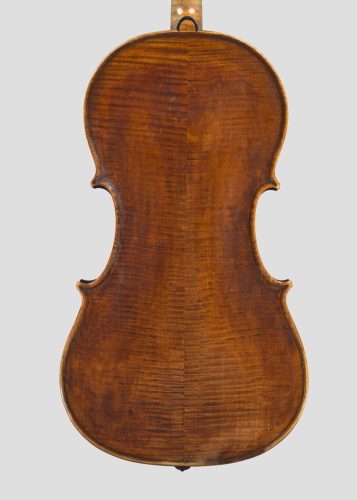Giovanni and Francesco Grancino
Viola by the brothers G. & F. Grancino, made in Milan cirka 1665. Ida Bryhn plays on this instrument.
The Grancino family of Milan were amongst the most significant violin makers outside Cremona in the late seventeenth century.
How they acquired their expertise is not yet known for certain; the senior member of the family was Andrea, who was active from about 1645 and died before 1673. Connections with the Amati family have been sought, but without any firm evidence emerging. The Hills, in their biography of the Guarneri family point to a Paolo Grancino who is said to have been a pupil of the Amati, but again, no support for this has yet been found to confirm the suggestion. The makers of this viola, the ‘Brothers’ Grancino, Francesco and Giovanni, were the sons of Andrea. Francesco worked from c.1660-1670, and some work bearing his individual label is known. Giovanni Battista was born in 1637 and died in 1709. Giovanni subsequently worked on his own, and passed his knowledge on to his son, Giovanni Battista II, and Carlo Giuseppe Testore. Together, however, the brothers produced a significant body of work bearing variations of the label ‘Gio e Francesco Fratelli de Grancini/ In Contrada Larga di Milano, 16..’ the Contrada Larga (now the Via Larga) being the address of their workshop in Milan.
What is most interesting is their focus on the 42cm contralto viola. This was still a relatively rare instrument in 17th century Italy, most makers favouring the tenor size, with a back length of over 43cm. Any form of viola in fact is quite rare in this period, most makers all but ignoring the middle voice of the violin family. There are two rare contraltos by the brothers Amati from the first part of the century, Stradivari made his first contralto model in 1672, and Andrea Guarneri followed suit with smaller violas made in 1676 and 1690. The Grancini made at least six such instruments on a form quite closely matched to the Guarneri form, but if the few original labels are to be trusted, pre-date them by up to a decade. Even more intriguing is that violins attributed to the Grancino brothers are relatively rare, and cellos all but unknown. By some quirk of circumstances in Milan in the late 17th century, the Grancinos seem to have become specialist makers of contralto violas.
This example is a very typical one. The workmanship is robust but accurate. The modelling owes a great deal to the earlier Brescian masters of the viola, Gaspar da Salo and Maggini, with a full, rounded arching, but the details of finish and design are very much Amati-inspired. The head is quickly and unevenly cut, but has the energy and character of all the best Italian work. The soundholes have a distinctive swagger, with the nicks placed high up on the arm, adding to the slightly unbalanced effect. The varnish of this viola is spectacular; on the back it is particularly well preserved, with a strongly crackled surface and a rich, dark ruddy brown tint, anticipating that of the great Venetian makers of the eighteenth century.
This size and form of viola is ideally suited to modern performance, and such an early example is a great treasure of instrument making. After Francesco relinquished his place in the workshop for unknown reasons in about 1670, his brother Giovanni Battista carried on alone, developing a much more delicate and personal style, with low elegantly scooped archings in the Amati style, and very Stradivarian soundholes. The varnish he used was a very clear yellow-gold, quite different to the previous recipe. He made only one or two violas with his own label.

Ida Bryhn
Ida Bryhn (b. 1981) from Oslo, is principal viola of the Norwegian Chamber Orchestra and also teaches at the Norwegian Academy of Music. She has performed at most major concert halls in Europe and the US.









